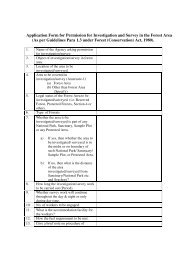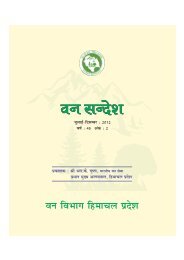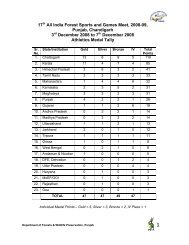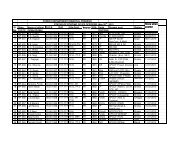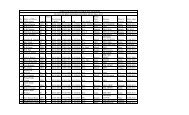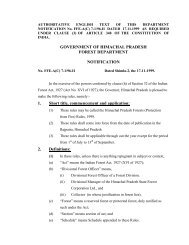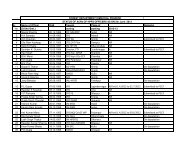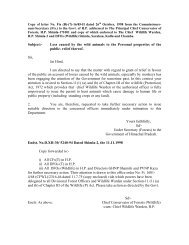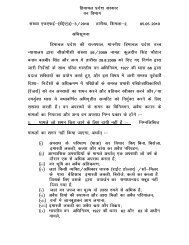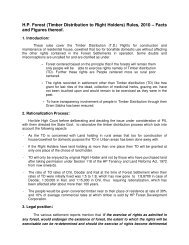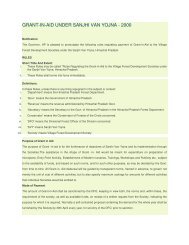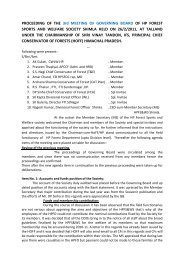Monkey Survey Guidlines - HP Forest Department
Monkey Survey Guidlines - HP Forest Department
Monkey Survey Guidlines - HP Forest Department
Create successful ePaper yourself
Turn your PDF publications into a flip-book with our unique Google optimized e-Paper software.
FOREST DEPARTMENT HIMACHAL PRADESHWILD LIFE WINGNo.WL/ <strong>Monkey</strong> Menace/WLM/ 1156-1210Dated, Shimla-1, the 30/5/2013From: Pr.CCF (Wildlife)-cum-Chief Wildlife Warden, H.P.To: 1) All CCFs /CFs (WL) & (T)2) All DFOs (WL) & (T)Subject:<strong>Survey</strong> for population estimation of Common <strong>Monkey</strong>s(Rhesus Macaques) and Langurs in the State of HimachalPradesh.Memo:You all are well aware of the fact that monkey population in theState is stated to be on the rise and increasingly becoming semi-commensal andcommensal* due to change in their feeding habits in a wide range of habitats.The semi-commensal and commensal behavior of monkey is attributed toincreased interaction of these primates with humans especially in urban areas,road sides, villages etc. and other public places etc. The monkey humaninteraction is increasingly acquiring monkey man conflict dimensions oftenreferred to as “monkey menace”. At many places the monkey menace isbecoming alarming and in agricultural fields monkeys are becoming increasinglyagricultural pest. The Wildlife Wing of <strong>Forest</strong> <strong>Department</strong> has the mandate toidentify strategies and suggest solution and devise control mechanisms to themonkey menace and formulate a comprehensive management plan.2. Currently, there is no updated estimation of monkey populationsince December, 2004 in the State (though partial monkey census surveys havebeen carried out in 2010 & 2012 in selected <strong>Forest</strong> Divisions) therefore; it hasbeen decided to carry out a detailed survey of the population of monkeys andlangurs in the State in all the rural, urban and forest areas. The monkeypopulation survey will have following objectives:-1) To estimate the population of monkeys/langurs in the State in Varioushabitats.________________________________________________________*Commensal habitats are considered to be villages, towns, cities, templesand railway stations where monkeys are in close and frequent contact withpeople throughout the day. “Semi-commensal” habitats are roadsides,bare lands (not National Parks or extensive forest parts) and canal bankswhere monkeys and people are in some human contact. “Noncommensal”habits are forest areas, where monkeys are usually shy ofpeople and not them at all for food.
2) To estimate the population growth trend and fertility rate of the monkeys invarious habitats e.g. urban, semi-urban, road sides, rural villages, templesand forests etc.3) To assess the migration trend of the monkeys from non-commensalhabitats to semi-commensal & commensal habitats i.e. from forest areastowards rural and urban areas.4) To assess the extent of man-monkeys conflict.5) To identify the areas and pockets where man-monkey conflict is alarming.6) To assess the efficacy of monkey sterilizations.SCHEDULE OF MONKEY/LANGURS POPULATION ESTIMATION SURVEY:3. The survey of monkey population shall be carried out in 2013 in twophases. The first phase of the survey will be done in June, 2013 and secondphase will be conducted in December, 2013. This has been necessitated due totwo distinct breeding cycles of Rhesus monkeys.The first State wide comprehensive survey will be carried out on29s th June, 2013 and subsequently repeated in December, 2013.4. <strong>Monkey</strong>/langur population has to be done by head counting of male,female, and juvenile/young monkeys/langur in each troupe and number oftroupes at each location. The status of monkey/langur population will beestimated in 5 categories viz. forests, urban, rural, temples & road sidesseparately by following “Direct Head count method”.5. The survey shall be carried out from 7 AM to 5.30 PM on 29 th June, 2013throughout the State by all <strong>Forest</strong> Guards in their beats. The Territorial <strong>Forest</strong>Guard will carry out the monkey/langur population count throughout their beatjurisdiction. Similarly, the Wildlife Guard will carry out population estimate surveywithin their Wildlife Beats. The survey will cover all locations urban, rural, forest,temples and road sides falling within the jurisdiction of forest guards.6. The <strong>Forest</strong> Guards will start the survey process from 21 st June onwardswhen they will observe and note down the locations and movement routeswhere monkey troupes are concentrated in their beats. This observation processwill continue for a week from 21st June to 27 th June, 2013.7. On 28 th June, 2013, one day before the actual head counting of monkeypopulation, all forest guards will carry out a pre-survey of all monkey/langurtroupes locations and estimate population of each troupe.8. On 29 th June, 2013 the survey will begin at 7 AM in the morning and willend at 5.30 PM in the evening. The <strong>Forest</strong> Guard will visit all the monkey/langurtroupes locations identified during the pre-survey period from 7 AM onwards.
The details of monkey/langur population found at each troupe location will befilled in table No. 1 (Annexure-1). The <strong>Forest</strong> Guards may require a team of 3-4<strong>Forest</strong> Workers to assist them in visiting various monkey/langur troupe locations.The teams shall be provided by respective ROs/BOs. Sufficient number ofcopies of Table No. 1 is to be supplied to each forest guard through concernedRange Officers with photocopying of these survey guidelines. The format ofTable No. 1 is enclosed with these guidelines. The survey will conclude at 5.30PM on 29 th June, 2013.9. On the following day on 30 th June, 2013, (Sunday), all forest guards willcarry out a Post <strong>Survey</strong> verification check. This post verification will again bedone from 7.00 AM to 5.30 PM by all forest guards and to verify the correctnessof their monkey/langur counting done on previous day on 29th June, 2013.TRAINING IN SURVEY METHODOLOGY:<strong>Survey</strong> shall have following phases:Phase-I- (a) 7 th June, 2013 to 13 th June, 2013-Contact with DFOs.Contact with DFOs (T) and DFOs (WL)-Clarification of <strong>Survey</strong> ProcedureDuring this period survey coordinators and the training teamsconstituted for overseeing and supervising survey process will get in touch withall DFOs (T) & DFOs (WL) to ensure that all of them understood the surveyprocess and Table 1,2 & 3 in which survey population is to be filled by <strong>Forest</strong>Guards (Table No. 1) compiled by Range Officer at Range level (Table 2) and(Table 3) compiled at Division level.Phase-II- (b) 14 th June, 20134 to 20 th June, 2013-Workshops of ROs,BO,Fgds &field staff..During this period all DFOs (T) and DFOs (WL) will discuss the surveyformats and tables (1,2 & 3) and process of census with all Range Officers. TheRange Officers in turn will explain the survey procedure and process to allDeputy Rangers and <strong>Forest</strong> Guards of their Ranges by calling specialmeeting/workshops to explain the importance of the survey & actual surveyprocess and distribute sufficient copies of Table 1 to <strong>Forest</strong> Guards withinstructions to photocopy the Table 1, If the <strong>Forest</strong> Guards require more copiesto cover all monkey/ langur troupes and locations within their beats. Allclarifications and doubts if any will be clarified in consultation with surveycoordinators.Phase-III-(c) 21 st June, 2013 ro 27 th June, 2013-Observation Period by Fgds infield.During this period the <strong>Forest</strong> Guards will start monitoring monkey troupeslocations within their beats to ensure that all monkey locations are properlyidentified. During this period Range Officers will also give necessary clarificationabout the survey procedure and process that the <strong>Forest</strong> Guards might seek &
also verify that the beat guards are monitoring and observing period from 28 thJune,2013 to 30 th June, 2013 the monkey/langur troupes.Phase-IV- (d)-28 th June, 2013 as explained above will be pre-survey day.Phase-V (e) 29 th June, 2013-<strong>Survey</strong> Day.29 th June, 2013 will be the actual survey day. <strong>Monkey</strong>/Langurpopulation counted at each location where monkey/langur population have beenconcentrated will be recorded location wise. The Tables for monkey and langurpopulations have been observed during observation period 21 st June to 27 thJune, 2013 will be compiled separately at each level.Phase-VI-(f)-30 th June-Post <strong>Survey</strong> Verification day.On 30th June, 2013, Post survey verification of monkey/langur populationrecorded will be done to ensure recording and compiling all monkey/langurpopulation, number of troupes that has been left out during actual survey and toconfirm that all monkey troupes have been counted for in the beat. The Blockofficers and Range Officers will supervise the survey done in their jurisdiction.Range Officer (WL) in addition to the organizing survey within their jurisdiction,will also coordinate the monkey/langur population survey within their entirejurisdiction and get in touch with Territorial Range Officers within their jurisdictionfor this purpose of survey and training (if required) and provide necessaryclarifications sought by territorial staff. The Block Officers shall also verify thatthere is no overlapping of monkey/langur troupes counting by the <strong>Forest</strong> Guardsof adjacent beats on 29 th June, 2013, the survey dayPhsae-VIII (g)- 1 st July, 2013 to 7 th July, 2013.COMPILATION OF MONKEY SURVEY RESULTS:a) Submission of <strong>Survey</strong> Results by <strong>Forest</strong> Guards to RangeOfficers by 3 rd July. All <strong>Forest</strong> Guards will submit their populationsurvey results to their Range Officers latest by 3 rd July, 2013.b) Submission of <strong>Survey</strong> Results by Range Officers to Divisional<strong>Forest</strong> Officers by 5 th July, 2013: The Range Officers in turn willcompile the result beat wise for their Range in Table No. 2 and submitsurvey results of their ranges to their DFO(T) or DFO (WL) as the casemay be, by 5 th July, 2013.c) Submission of <strong>Survey</strong> Results by DFOs (T) & DFOs (WL) to CCF(WL) by 10 th July, 2013,The DFO (T) and DFOs (WL) will compile the Range wise results and submit it toCCF Wildlife (North) or CCF WL (South) on Table No. 3 along with all Tables No.1 & 2 in original.
<strong>Forest</strong> Divisions falling in Territorial Circles in Chamba, Dharamshala, Mandi &Hamirpur and WL Divisions under the jurisdiction of CCF WL D/shala will sendthe survey result of their divisions to Shri Suresh Kumar, IFS, CCF WL D/shalaby 10 th July, 2013.Similarly, <strong>Forest</strong> Divisions falling in Territorial Circles, Bilaspur, Shimla, Rampurand Nahan and WL Divisions under the jurisdiction of CCF WL Shimla and DFOMC Shimla will send the <strong>Monkey</strong> population survey of their Divisions on Table 3along with all table No. 2 (Range results) and Table 1 (Beat results) in original toShri Rakesh Sood, IFS, CCF WL Shimla latest by 10 th July, 2013.<strong>Forest</strong> Divisions fall in Kullu territorial circle shall send survey results of theirdivisions to CCF GHNP Shamshi. The CCF GNHNP shall also compile thecensus results of GHNP & DFO WL Kullu on Table No. 3 along with all table No.2 (Range results and Table 1 beat results) .10. Compilation of <strong>Survey</strong> Results by CCFs (Wildlife) & submission toPr.CCF WL by 15 th July 2013.All the three CCFs (WL) North and South & CF GHNP Shamshi will then compilethe monkey population results division-wise and send the results to PCCF (WL)<strong>HP</strong> by 15 th July, 2013.11. The whole monkey population estimation survey is summarized as under:Phase-I 7 th June 2013 to13 th June 2013Phase-IIPhase-IIIDates <strong>Survey</strong> Schedule Purpose<strong>Survey</strong> Coordinators Provide clarificationand Training teams to regarding surveyensure all DFO (T) & process and(WL) have received procedureguidelines14 th June 2013 to Familiarization with20 th June 201321 st June 2013 to27 th June 2013survey procedure anddistribution of surveyformats.Identification of<strong>Monkey</strong>/ langurtroupes locationTraining of Field staffand distribution ofsurvey formats to<strong>Forest</strong> Guards.Identification oflocation of monkey/langur population byforest guards inbeats.Phase-IV 28 th June 2013 Pre-survey Patrolling of area formonkey / langurpopulation in a forestbeat.Phase-V 29 th June 2013 Actual census Actual verification ofnumber of monkeysPhase-VI 30 th June 2013 Post census Observation for anyleft out troupes andincluding in surveyresults.
This may be treated as the most urgent.Kindly acknowledge the receipt of the letter.Sd/-(Ashwanii Gulaati) IFS ,Principal Chief Conservator of <strong>Forest</strong>s,(WL)–cum-CWLW, <strong>HP</strong> Shimla-1.Copy to:DFO MC Shimla. He is requested to depute his staff for thecensus of <strong>Monkey</strong>s on scheduled dates within Shimla Municipal limits andcoordinate with DFO WL Shimla and submit the results of monkey/Langur surveyto CCF (Wildlife) Shimla. Sd/-(Ashwanii Gulaati) IFS ,Principal Chief Conservator of <strong>Forest</strong>s,(WL)–cum-CWLW, <strong>HP</strong> Shimla-1.



